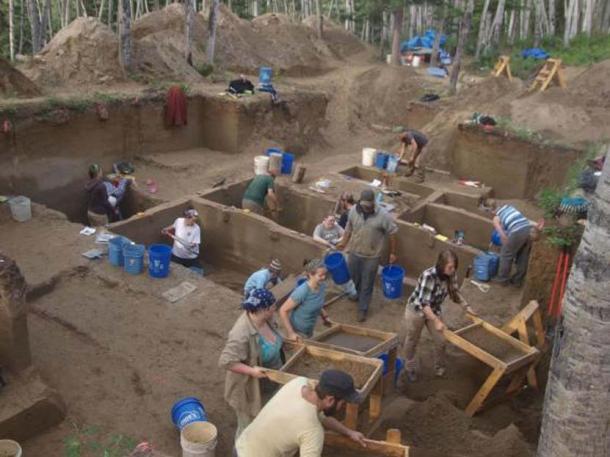
Ancient Infant DNA Rewrites the History of Humans Entering North America
Scientists claim that a genetic analysis of the 11,500-year-old remains of an infant girl from Alaska has shed new light on the populating of the Americas. The new finds suggest that the “Last Frontier” was inhabited way earlier than what we have thought until now.
Oldest Human Remains Ever Discovered in Alaska
In what may be one of the greatest discoveries in Alaska’s history, an international team of researchers led by scientists from the University of Cambridge and the University of Copenhagen claims to have discovered the first direct genetic evidence of the earliest Native Americans. The genetic analysis of the ancient remains of an infant girl from Alaska not only reveals a previously unknown indigenous population, but also indicates that humans traveled across the Beringia land bridge to reach the North American continent in a single migratory wave from Siberia over 20,000 years ago. As BBC News reports, Dr. Eske Willerslev and his colleagues suggest that the pioneering settlers became the ancestors of all contemporary Native Americans.
- Ancient Bronze Artifacts in Alaska Reveals Trade with Asia Before Columbus Arrival
- 12,300-Year-Old Bone Pendants May be Oldest Artwork Ever Discovered in Alaska

A family of Iñupiat from Noatak, Alaska, 1929 - by Edward S. Curtis. (Public Domain)
The scientists successfully sequenced the genome of a six-week-old female infant unearthed at the Upward Sun River site in Alaska and discovered that she’d lived around 11,500 years ago. According to The New York Times, the remains of the girl represent the second-oldest human genome ever discovered in North America.
“Sunrise Child-Girl” Will Provide Accurate Picture of Native American Prehistory
The local Native American community named her Xach'itee'aanenh t'eede gay, which translates to the “Sunrise Child-girl.” The science team refers to her simply as USR1. Curiously, her genetic code didn’t match with any of the two native populations known to exist during that period.
"These are the oldest human remains ever found in Alaska, but what is particularly interesting here is that this individual belonged to a population of humans that we have never seen before," Dr. Willerslev told BBC News.
The genetic analysis of the girl’s remains pinpoints towards a separation of all ancient Native Americans from a single east Asian source population somewhere between 36,000 to 25,000 years ago, way before humans crossed into Beringia, an area that includes the land bridge connecting Siberia and Alaska at the end of the last ice age. “You can say she comes from the earliest, or most original, Native American group - the first Native American group that diversified. And that means she can tell us about the ancestors of all Native Americans,” Dr. Willerslev tells BBC News.
- Children of the Upward Sun River: 11,500-Year-Old Remains Shed Light on Alaska’s Earliest Inhabitants
- Two infant graves dating back 11,500 years found in Alaska

The infant’s remains were discovered in excavations at the Upward Sun River site in Alaska (Image: Ben Potter)
Two Possible Scenarios
Furthermore, the new study indicates two possible scenarios as to how the separation probably happened. The first theory proposes that the two groups became isolated while still in East Asia, and that they crossed the land bridge separately, possibly at different times or by using different routes. The second scenario suggests that a single group moved out of Asia, then split into Beringians and ancient Native Americans once in Beringia. The Beringians stayed way longer than they needed to in the West and interior of Alaska, while the ancestors of contemporary Native Americans moved on South sometime around 15,700 years ago as the National Geographic reports.
Dr. Ben Potter, an anthropologist at the University of Alaska Fairbanks and one of the lead authors of the study, hesitates to come to any safe conclusions for the time being, "It would be difficult to overstate the importance of this newly revealed people to our understanding of how ancient populations came to inhabit the Americas," he said as The Independent reported. And added, “These findings create opportunities for Alaska native people to gain new knowledge about their own connections to both the northern Native American and Ancient Beringian people. {Additionally} the new information will allow us a more accurate picture of Native American prehistory. It is markedly more complex than we thought."
- Rare Bones and DNA of tiny children surprise scientists, support ideas about migration into the Americas 11,000 years ago
- Archaeologists Discover Pre-Contact Native Village in Alaska

Group of Native American chiefs in 1865. According to the study, Northern and Southern American Indians split between 14000 and 17000 years ago. (Public Domain)
Ultimately, an excited with the new finds of the analysis Dr. Willerslev tells BBC News, "Before this girl's genome, we only had more recent Native Americans and ancient Siberians to try to work out the relationships and times of divergence. But now we have an individual from a population between the two; and that really opens the door to address these fundamental questions.” He believes that more conclusive answers will only come with the discovery of further remains in north-east Siberia and Alaska, and adds that only “time will tell.”
Top image: A scientific illustration of what the Upward Sun River camp, where the remains of the ancient child were discovered, would have looked like. Source: Eric Carlson in collaboration with Ben Potter.
















Comments
lets see, DNA new, not related to any known ones. But thus is a clue to when groups split off or diverged. Huh? unrelated means NO discernible connection. What it means is that a "new" group migrated from xxx in Asia or developed here. Get over the bigoted Asiancentric nonsense. It is more likely that the Siberians originated here. & moved west following horses, camels etc.